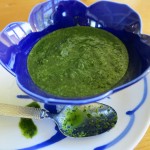Thai Cilantro Sauce
I adore herbaceous green sauces to embellish the simplest dishes – grilled chicken, pork…or juicy flank steak…a platter or raw tomatoes. Pestos made with basil, arugula, cilantro-pecan and tarragon wait in my freezer for just the recipe or menu idea. I’ve built blogs around other favorites, Argentinian Chimichurri and Italian Salsa Verde.
So when my husband shot me an email with a recipe for a Thai cilantro sauce he tasted in his lunchroom made by a colleague, I-Lay (pronounced eye-lie), I had to give it a whirl. It is zestier than zesty with the amalgam of flavors you expect from Thai cooking –citrusy acidity mixed with sweet, hot and herbaceous notes.
I used part of the sauce to spread personality on mild mannered Alaskan cod filets with a little extra salt and pepper before grilling.  We drizzled more cilantro sauce on at the table.
We drizzled more cilantro sauce on at the table.
Herbs have health benefits, including making food tasty with less salt and fat. Cilantro is a source of vitamin K and the health-promoting phytochemicals, apegenin, beta-carotene, kaemferol, quercetin, rutin. (Reference 1). Fresh chilis, another prominent ingredient in this dish, provide vitamins C and A.
Cilantro, sometimes called coriander leaves or Chinese parsley is a work horse in many cuisines around the world – Mexican and Latin American, Indian, Chinese, Southeast Asian, North African and the eastern Mediterranean. An ancient seasoning, records of cilantro’s use date back to 5000 BCE. (Reference 1). The cilantro roots are often ground and used as a seasoning and coriander seeds are widely used as a seasoning around the world, too.
I don’t serve cilantro-centric recipes to people whose palates I don’t know. It is a black or white food – people love it or hate it. The word cilantro is derived from a Greek word that means “stink bug” (Reference 1) which aligns with the opinion of those who dislike it, including the late culinary expert Julia Child, according to an article in the New York Times (Reference 2). The article explains that there may be a genetic link to the off-putting soapy aroma and flavor some describe. Chemists have identified compounds in cilantro, including fat fragments called aldehydes, that are the same or similar to those in soaps, lotions and some insects.
While there are reports of people turning their cilantro-aversions around with repeated positive exposures (Reference 2), there are plenty of cilantro aficionados who will enjoy this recipe. I was struck with its versatility as I whirled together the ingredients; swap the Thai peppers for serranos and added a little cumin to make a Latin sauce and spoon it over a taco. Or use to wake up that lunchtime sandwich, top off a bowl of your favorite bean or vegetable soup or….
Thai Cilantro Sauce
I adapted this recipe from I-Lay’s general directions and tamed it to our tastes by blanching the garlic and using fewer Thai chilies, which can be very hot. If you want to make it more mild, try substituting jalapenos which sometimes have little to no heat (try a tiny bit) and remove the seeds.
4 1/2 cups lightly packed washed, stemmed (small, tender stems are ok) cilantro leaves, about 2 generous bunches
6 cloves fresh garlic*
3 Thai chili peppers, seeds removed
3 to 4 teaspoons granulated sugar
1/2 teaspoon kosher salt
3 tablespoons fresh lime juice
2 tablespoons fish sauce
1/4 to 1/3 cup water (use water from simmering garlic)
In food processor container, combine cilantro, garlic, chili peppers, 3 teaspoons sugar and salt. Process until finely chopped, stopping to scrape bowl a couple of times. Add lime juice, fish sauce, and 1/4 cup water. Process again until blended. Taste and adjust ingredients to taste. Chill for at least 1 hour for flavors to blend. Makes 1 generous cup.
*To tame the raw garlic flavor simmer cloves in boiling water for 30 seconds. Cool. Reserve water for thinning sauce.
References:
1. American Institute for Cancer Research
2. Cilantro Haters, it’s not Your Fault, Harold McGee. The New York Times. April 13, 2010. Link to Article
Copyright© Lorelle S Del Matto 2012

 About lorelle
About lorelle
Love it! I want to try some of that salsa looks delicious. I ralely need to learn how to can did it take a bit upfront investment of stuff (I see the the big display of stuff at Target and get nervous)